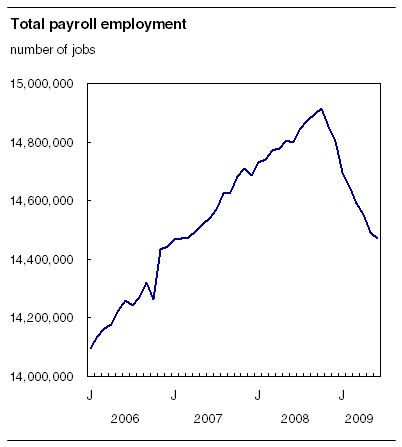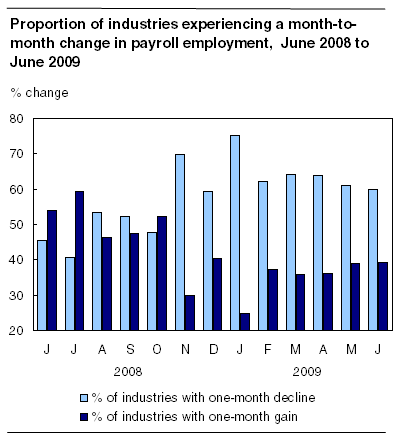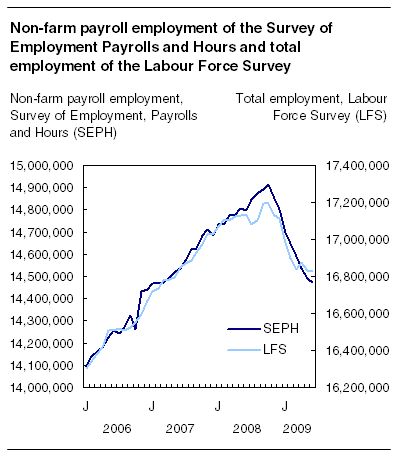Common menu bar links
Payroll employment, earnings and hours
Archived Content
Information identified as archived is provided for reference, research or recordkeeping purposes. It is not subject to the Government of Canada Web Standards and has not been altered or updated since it was archived. Please "contact us" to request a format other than those available.
Total non-farm payroll employment fell by 47,000 in June, down 0.3% from May, bringing total losses to 442,600 since the peak in October 2008. The proportion of industries experiencing job losses in June edged down to 60%.

These data come from the Survey of Employment, Payrolls and Hours (SEPH). SEPH is a business survey that provides a detailed portrait of employees from an industry perspective, complementing information on total employment from the Labour Force Survey (LFS), which is a survey from a household perspective.
In June, 183 of the 305 (60%) industries covered by the survey experienced declines, down from 186 (61%) in May. During this current economic downturn, the highest proportion of industries shedding jobs was in January at 75%.
Note to readers
Unless otherwise specified, data in this release refer to payroll employment and earnings data obtained from the Survey of Employment, Payrolls and Hours (SEPH).
Each month, Statistics Canada now provides enhanced analysis of the current labour market situation, using SEPH and other sources. The Labour Force Survey (LFS) will provide the first picture of overall labour market conditions, with unemployment and total employment and who is affected by changes in the labour market. Later in the month, Statistics Canada will provide additional detail by industry through the SEPH Daily release, and regional detail through the Employment Insurance statistics.
With the release of January 2009 SEPH data on March 31, 2009, an improved estimation method for earnings and hours data was introduced and estimates back to 2001 were revised to ensure continuity in data series.
Most of the job losses in June were in the service sector while losses within the goods sector were mainly in manufacturing.
Payroll employment fell in most provinces in June, particularly in Ontario and Alberta. Manitoba was the only province with a significant increase in payroll employment during the month.
The average weekly earnings of payroll employees, including overtime, was $823.23 in June. This increase of 1.8% from June 2008 was at a faster pace than the 1.3% gain observed between May 2008 and May 2009, but was down considerably from the most recent year-over-year peak in average weekly earnings of 3.0% in October 2008.
Heavy job losses in retail and wholesale trade
Payroll employment in services declined by 29,200 (-0.3%) in June. Nearly half of these job losses were in the retail and wholesale trade sector (-14,400). The largest payroll employment declines in this sector were in electronics and appliance stores (-2,100); department stores (-2,000); computer and communications equipment and supplies wholesaler-distributors (-2,000); and grocery stores (-1,800).
Employees in professional, scientific and technical services also experienced job losses, particularly those in accounting, tax preparation, bookkeeping and payroll services (-2,600); computer systems design and related services (-1,700); and management, scientific and technical consulting services (-1,100).
In June, the number of employees also fell in full-service restaurants (-3,200); business support services (-2,100); traveller accommodation (-2,000); and employment services (-1,700).
Despite fairly widespread losses in the service sector, some industries experienced job growth in June, such as elementary and secondary schools (+3,400); universities (+2,600); and insurance carriers (+2,200).
Job losses in fewer industries within manufacturing sector
There were job losses in 51 of 86 (59%) manufacturing industries in June, the fewest number of declines within manufacturing since July 2008.
In June, one-third of the 12,900 job losses in manufacturing were in plastic products (-1,800); architectural and structural metals (-1,400) and seafood product preparation and packaging (-1,100). The remaining job losses were spread out among 48 other manufacturing industries.
An increase in the number of non-residential construction employees (+2,200) in June was largely offset by a decline among building equipment contractors (-1,800), leaving overall construction payroll employment little changed from the month before. Since peaking in October 2008, the number of employees in construction has declined by 62,600 (-7.4%).

A review of recent trends in payroll employment by industry
Since labour market conditions began to deteriorate last autumn, payroll employment has fallen considerably. Since October 2008, at a detailed industry level, the largest declines have been in employment services (-29,100); support activities for mining and oil and gas extraction (-22,400); motor vehicle parts manufacturing (-18,500); and architectural, engineering and related services (-16,400).
Many other industries remain in sharp job decline, while a few have rebounded, or have experienced modest growth during the downturn.
Employment losses tied to the goods sector
Many of the industries to have payroll employment declines since October 2008 were in the goods sector, particularly manufacturing, construction and mining, or were in services with close ties to these goods industries. These include employment services (-29,100); architectural, engineering and related services (-16,400); both specialized (-10,000) and general (-7,100) freight trucking; automobile dealers (-5,500); and building supplies dealers (-4,800).
Industries with job growth since October 2008 have strong public sector activity
Since October 2008, of the industries that have had growth in payroll employment, many have strong ties to the public sector, including: other provincial and territorial public administration (+20,200); nursing care facilities (+10,300); and general medical and surgical hospitals (+8,600).
Average weekly earnings
The average weekly earnings of payroll employees, including overtime, was $823.23 in June. This increase of 1.8% from June 2008 was at a faster pace than the 1.3% gain observed between May 2008 and May 2009, but was down considerably from the most recent year-over-year peak in average weekly earnings of 3.0% in October 2008.
Between June 2008 and June 2009, average weekly earnings in Canada's largest industrial sectors were up 6.0% in health care and social assistance, 3.4% in public administration, 2.8% in retail trade and 0.1% in accommodation and food services.
For the same year-over-year period, average weekly earnings fell 5.4% in manufacturing and 2.4% in educational services.
Provincially, the biggest increase in average weekly earnings was in Prince Edward Island, increasing by 6.5% from June 2008 to June 2009. Over the same period, average weekly earnings rose by 4.9% in Newfoundland and Labrador and 4.3% in Alberta. Ontario experienced the smallest year-over-year increase at 0.7%.
Total hours
Compared with a year earlier, the total hours worked by hourly paid employees in Canada fell by 1.8% in June. Since the the growth in total hours worked by hourly paid employees, including overtime, peaked in October 2008, year-over-year growth in hours worked has slowed, slipping into negative territory in May and June.
Comparing SEPH and LFS
Data on employment, wages and hours worked are produced by two major Statistics Canada monthly surveys: LFS and SEPH. Survey estimates differ for conceptual reasons and for methodological reasons. The information source is the key distinction between the two surveys: SEPH provides information related to occupied jobs based on a census of administrative data from businesses whereas LFS provides information on the employment characteristics of individuals based on a survey of households. While the estimates from the survey do differ, the trends in the data are quite similar.

Since each of these surveys addresses different needs, the choice of data depends on the users' goals. Other conceptual and methodological differences between the two surveys include: degree of coverage of industries and the self-employed, treatment of multiple-job holders, and the survey reference period. The effects of these differences vary by industry.
Available on CANSIM: tables 281-0023 to 281-0039 and 281-0041 to 281-0046.
Definitions, data sources and methods: survey number 2612.
Detailed industry data, data by size of enterprise based on employment, and other labour market indicators will be available soon in the monthly publication Employment, Earnings and Hours (72-002-X, free).
Data on payroll employment, earnings and hours for July will be released on September 30.
For more information, or to order data, contact Client Services (toll-free 1-866-873-8788; 613-951-4090; labour@statcan.gc.ca). To enquire about the revisions, or the concepts, methods or data quality of this release, contact Jason Gilmore (613-951-7118), Labour Statistics Division.
Table 1
| Industry group (North American Industry Classificiation System) | December 2008 | June 2008 | May 2009r | June 2009p | May to June 2009 | June 2008 to June 2009 | December 2008 to June 2009 |
|---|---|---|---|---|---|---|---|
| Seasonally adjusted | |||||||
| thousands | % change | ||||||
| Industrial aggregate | 14,800.4 | 14,799.3 | 14,518.3 | 14,471.3 | -0.3 | -2.2 | -2.2 |
| Forestry, logging and support | 44.7 | 47.5 | 37.9 | 38.2 | 0.8 | -19.6 | -14.5 |
| Mining and quarrying, and oil and gas extraction | 203.5 | 200.0 | 182.6 | 177.0 | -3.1 | -11.5 | -13.0 |
| Utilities | 122.7 | 120.1 | 119.5 | 119.8 | 0.3 | -0.2 | -2.4 |
| Construction | 817.7 | 832.1 | 784.1 | 785.1 | 0.1 | -5.6 | -4.0 |
| Manufacturing | 1,599.6 | 1,675.4 | 1,484.9 | 1,471.9 | -0.9 | -12.1 | -8.0 |
| Wholesale trade | 753.7 | 758.5 | 731.6 | 725.7 | -0.8 | -4.3 | -3.7 |
| Retail trade | 1,884.0 | 1,905.9 | 1,864.2 | 1,856.3 | -0.4 | -2.6 | -1.5 |
| Transportation and warehousing | 696.7 | 695.7 | 677.0 | 672.8 | -0.6 | -3.3 | -3.4 |
| Information and cultural industries | 326.3 | 324.2 | 323.5 | 323.5 | 0.0 | -0.2 | -0.9 |
| Finance and insurance | 666.4 | 655.3 | 664.2 | 668.1 | 0.6 | 2.0 | 0.3 |
| Real estate and rental and leasing | 246.8 | 254.1 | 240.1 | 239.8 | -0.1 | -5.6 | -2.8 |
| Professional, scientific and technical services | 766.6 | 750.4 | 744.2 | 733.1 | -1.5 | -2.3 | -4.4 |
| Management of companies and enterprises | 121.3 | 122.3 | 117.9 | 115.9 | -1.7 | -5.2 | -4.5 |
| Administrative and support, waste management and remediation services | 754.2 | 779.3 | 719.1 | 712.7 | -0.9 | -8.5 | -5.5 |
| Educational services | 1,147.5 | 1,136.2 | 1,145.9 | 1,151.7 | 0.5 | 1.4 | 0.4 |
| Health care and social assistance | 1,567.2 | 1,519.0 | 1,574.9 | 1,576.9 | 0.1 | 3.8 | 0.6 |
| Arts, entertainment and recreation | 242.1 | 239.5 | 250.9 | 250.3 | -0.2 | 4.5 | 3.4 |
| Accommodation and food services | 1,095.3 | 1,070.9 | 1,066.4 | 1,057.1 | -0.9 | -1.3 | -3.5 |
| Other services (excluding public administration) | 510.5 | 508.0 | 504.5 | 504.4 | 0.0 | -0.7 | -1.2 |
| Public administration | 1,024.4 | 999.9 | 1,032.1 | 1,030.0 | -0.2 | 3.0 | 0.5 |
| Provinces and territories | |||||||
| Newfoundland and Labrador | 192.4 | 189.7 | 191.0 | 188.0 | -1.6 | -0.9 | -2.3 |
| Prince Edward Island | 61.5 | 60.8 | 63.0 | 63.1 | 0.2 | 3.8 | 2.6 |
| Nova Scotia | 393.0 | 397.0 | 391.6 | 390.8 | -0.2 | -1.6 | -0.6 |
| New Brunswick | 311.0 | 314.6 | 307.0 | 307.3 | 0.1 | -2.3 | -1.2 |
| Quebec | 3,393.1 | 3,368.6 | 3,345.0 | 3,341.6 | -0.1 | -0.8 | -1.5 |
| Ontario | 5,671.0 | 5,708.6 | 5,544.9 | 5,521.8 | -0.4 | -3.3 | -2.6 |
| Manitoba | 562.8 | 560.9 | 559.3 | 561.3 | 0.4 | 0.1 | -0.3 |
| Saskatchewan | 439.9 | 434.5 | 440.2 | 439.7 | -0.1 | 1.2 | 0.0 |
| Alberta | 1,789.8 | 1,768.8 | 1,728.5 | 1,713.0 | -0.9 | -3.2 | -4.3 |
| British Columbia | 1,935.0 | 1,941.3 | 1,884.3 | 1,880.4 | -0.2 | -3.1 | -2.8 |
| Yukon | 19.5 | 19.6 | 19.2 | 19.2 | 0.0 | -2.0 | -1.5 |
| Northwest Territories¹ | 26.8 | 25.5 | 26.5 | 27.4 | 3.4 | 7.5 | 2.2 |
| Nunavut¹ | 10.1 | 10.4 | 10.2 | 10.3 | 1.0 | -1.0 | 2.0 |
Table 2
| Industry group (North American Industry Classificiation System) | June 2008 | May 2009r | June 2009p | May to June 2009 | June 2008 to June 2009 |
|---|---|---|---|---|---|
| Seasonally adjusted | |||||
| $ | % change | ||||
| Industrial aggregate | 808.91 | 817.87 | 823.23 | 0.7 | 1.8 |
| Forestry, logging and support | 940.90 | 810.36 | 836.82 | 3.3 | -11.1 |
| Mining and quarrying, and oil and gas extraction | 1,501.91 | 1,625.78 | 1,714.51 | 5.5 | 14.2 |
| Utilities | 1,439.14 | 1,481.41 | 1,490.02 | 0.6 | 3.5 |
| Construction | 999.19 | 1,044.84 | 1,066.24 | 2.0 | 6.7 |
| Manufacturing | 960.48 | 899.94 | 908.51 | 1.0 | -5.4 |
| Wholesale trade | 942.53 | 969.98 | 1,007.25 | 3.8 | 6.9 |
| Retail trade | 470.19 | 489.66 | 483.41 | -1.3 | 2.8 |
| Transportation and warehousing | 874.49 | 882.28 | 876.02 | -0.7 | 0.2 |
| Information and cultural industries | 1,004.55 | 1,126.14 | 1,111.39 | -1.3 | 10.6 |
| Finance and insurance | 996.89 | 1,042.40 | 1,037.83 | -0.4 | 4.1 |
| Real estate and rental and leasing | 791.41 | 745.80 | 798.88 | 7.1 | 0.9 |
| Professional, scientific and technical services | 1,094.05 | 1,122.67 | 1,150.54 | 2.5 | 5.2 |
| Management of companies and enterprises | 1,083.20 | 1,090.62 | 1,165.50 | 6.9 | 7.6 |
| Administrative and support, waste management and remediation services | 701.10 | 645.34 | 657.33 | 1.9 | -6.2 |
| Educational services | 872.57 | 844.23 | 851.39 | 0.8 | -2.4 |
| Health care and social assistance | 733.55 | 782.25 | 777.67 | -0.6 | 6.0 |
| Arts, entertainment and recreation | 508.13 | 509.81 | 510.30 | 0.1 | 0.4 |
| Accommodation and food services | 328.14 | 336.63 | 328.45 | -2.4 | 0.1 |
| Other services (excluding public administration) | 688.19 | 684.86 | 693.70 | 1.3 | 0.8 |
| Public administration | 1,036.14 | 1,060.25 | 1,071.77 | 1.1 | 3.4 |
| Provinces and territories | |||||
| Newfoundland and Labrador | 766.97 | 803.30 | 804.81 | 0.2 | 4.9 |
| Prince Edward Island | 649.37 | 686.16 | 691.63 | 0.8 | 6.5 |
| Nova Scotia | 707.28 | 727.64 | 726.11 | -0.2 | 2.7 |
| New Brunswick | 723.90 | 738.01 | 737.45 | -0.1 | 1.9 |
| Quebec | 750.54 | 752.03 | 770.86 | 2.5 | 2.7 |
| Ontario | 837.66 | 843.11 | 843.43 | 0.0 | 0.7 |
| Manitoba | 745.40 | 763.15 | 765.26 | 0.3 | 2.7 |
| Saskatchewan | 783.53 | 802.72 | 803.77 | 0.1 | 2.6 |
| Alberta | 923.07 | 943.78 | 962.77 | 2.0 | 4.3 |
| British Columbia | 791.11 | 798.49 | 798.75 | 0.0 | 1.0 |
| Yukon | 863.26 | 891.72 | 898.96 | 0.8 | 4.1 |
| Northwest Territories¹ | 1,052.89 | 1,141.62 | 1,117.62 | -2.1 | 6.1 |
| Nunavut¹ | 889.17 | 879.77 | 867.31 | -1.4 | -2.5 |

